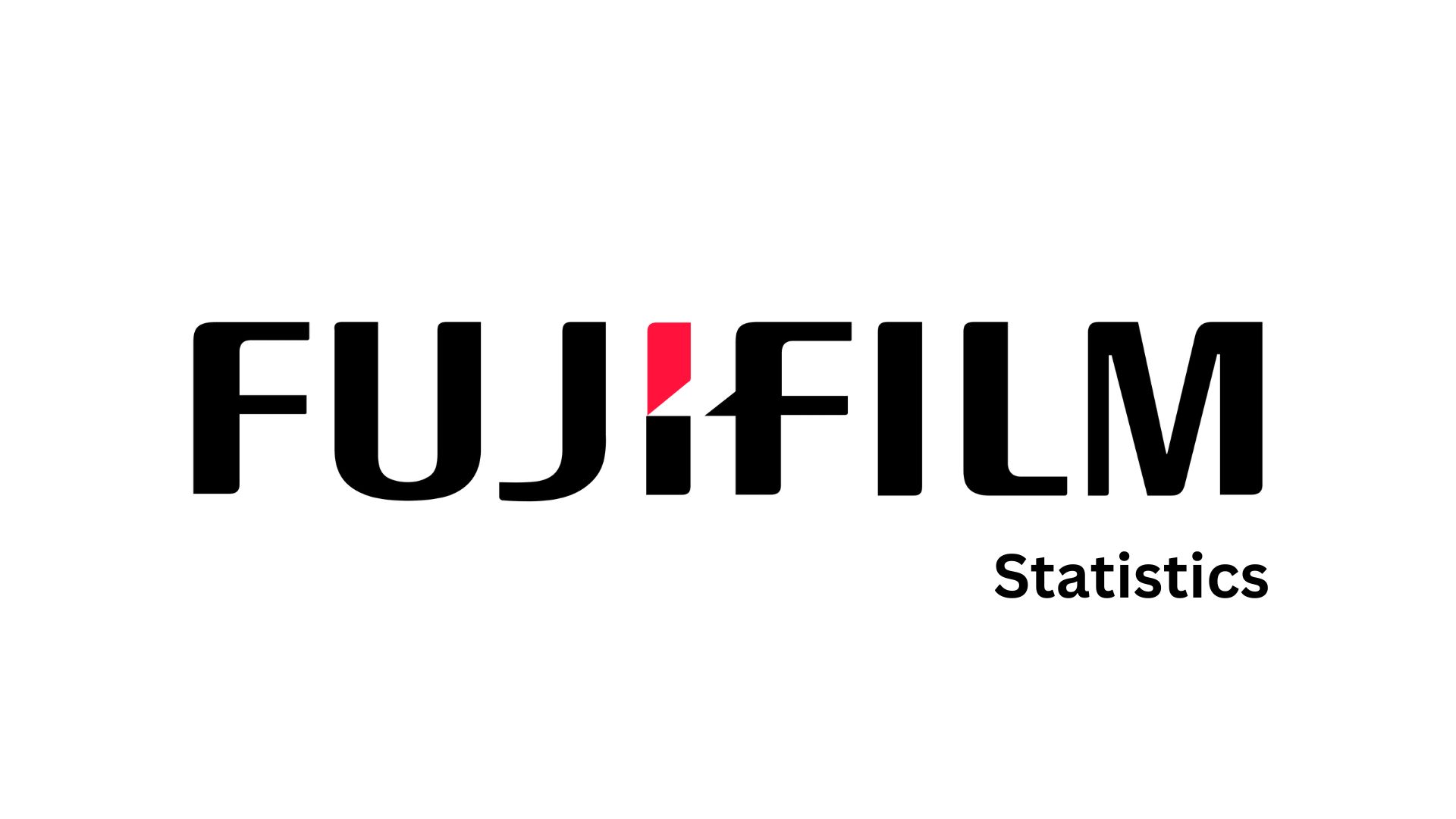Fujifilm Statistics By Revenue, Business, Market And Facts (2025)

Updated · Aug 07, 2025


WHAT WE HAVE ON THIS PAGE
- Introduction
- Editor’s Choice
- Origins and Evolution of Fujifilm
- Annual Revenue and Financial Performance
- Imaging and Camera Business Statistics
- Healthcare and Bio‑CDMO Segment
- Electronics and Advanced Materials Segment
- Imaging and Business development Segment
- Balance Sheet and Financial Ratios
- Workforce and Global Presence
- Sustainability and Environmental Commitments
- Strategic Outlook and Future Growth (Vision 2030)
- Conclusion
Introduction
Fujifilm Statistics: When you hear the name Fujifilm, your mind probably jumps to cameras, old-school film rolls, or those stylish Instax prints. But trust me, there’s a lot more happening behind this Japanese company than meets the eye. In this article, I’m going to walk you through the most detailed and up-to-date Fujifilm statistics you’ll find online.
From how the company started way back in 1934 to where it stands today in the world of healthcare, biopharmaceuticals, printing, and digital imaging, everything you need to know. Whether you’re someone who loves photography, a tech analyst, or just someone curious about how a once film-only brand transformed itself into a multi-industry empire.
I’ll cover revenues, product sales, market positions, employee strength, sustainability efforts, and so much more. So, everything about Fujifilm statistics. Let’s explore everything about the company.
Editor’s Choice
- Fujifilm was founded in 1934 and has since evolved from a photographic film company into a global giant in imaging, healthcare, and biotechnology.
- The company generated approximately ¥3 trillion (around $20.1 billion) in total revenue in FY2023, showcasing strong performance despite industry shifts.
- Imaging Solutions, including digital cameras and Instax, brought in over ¥378.1 billion, driven by continued demand for hybrid photography.
- The Instax series remains one of Fujifilm’s best-selling products, with more than 10 million units shipped annually across global markets.
- Fujifilm’s mirrorless X-Series and GFX cameras have gained a loyal following, helping the brand rank third globally in mirrorless camera shipments.
- Its medical systems division generated over ¥650 billion, with a strong focus on AI-powered diagnostics and healthcare imaging devices.
- Fujifilm has invested more than $2 billion in biopharmaceuticals, expanding its capabilities in cell therapy, regenerative medicine, and biologics manufacturing.
- The graphic communications and printing segment contributes approximately ¥400 billion annually, supplying packaging, labels, and commercial printing markets.
- Sustainability is core to Fujifilm’s vision, with a target to achieve net-zero carbon emissions by 2040, backed by heavy R&D with 2,500+ patents filed yearly.
- With over 80,000 employees in 50+ countries, Fujifilm’s influence is global, making it a major force not just in imaging, but in healthcare and technology too.
| No. | Category | Highlight |
| 1 | Foundation |
Established in 1934 as Fuji Photo Film Co., Ltd. |
|
2 |
Annual Revenue | ¥3 trillion ($20.1B) in FY2023 |
| 3 | Imaging Solutions |
¥378.1B revenue from cameras & photo goods |
|
4 |
Instax Sales | 10M+ units sold yearly worldwide |
| 5 | Mirrorless Camera Rank |
3rd globally in the mirrorless camera market |
|
6 |
Medical Systems | ¥650B revenue; AI imaging & diagnostics |
| 7 | Biotech & Pharma |
$2B+ investment in regenerative medicine |
|
8 |
Graphic Printing | ¥400B revenue in commercial printing |
| 9 | Sustainability Goals |
Net-zero target by 2040; 2,500+ patents/year |
|
10 |
Workforce & Reach |
80,000+ employees across 50+ countries |
Origins and Evolution of Fujifilm

- Fujifilm was founded in 1934 in Japan as Fuji Photo Film Co., Ltd., with an initial goal to produce photographic film domestically instead of relying on imports.
- In the early years, it focused on motion picture film, X-ray film, and photographic film for consumer use.
- By the 1950s, Fujifilm had already begun exporting its film to overseas markets, marking its early steps into globalization.
- The company established its first overseas office in the United States in 1965, laying the foundation for future international growth.
- During the 1980s, Fujifilm invested heavily in research and development, preparing for a digital future even when film dominated.
- In contrast to Kodak, Fujifilm didn’t resist digital photography; it embraced it. This decision helped it survive the fall of the analog era.
- In 2006, the company restructured under FUJIFILM Holdings Corporation, signaling a major shift in its business strategy toward diversification.
- Over the last 20 years, Fujifilm has transformed into a conglomerate involved in medical imaging, pharmaceuticals, biotech, document solutions, and digital cameras.
- As of 2024, Fujifilm operates in over 50 countries, with R&D centers and manufacturing plants across Japan, the US, and Europe.
- Today, it stands as a symbol of business reinvention, shifting from declining markets to new growth frontiers through development and adaptability.
| Year | Milestone |
| 1934 | Founded as Fuji Photo Film Co., Ltd. |
| 1950s | Started global film exports |
| 1965 | Opened the first overseas office in the US |
| 1980s | Major investments in R&D |
| 2006 | Became Fujifilm Holdings Corporation |
| 2024 | Operates in 50+ countries globally |
Annual Revenue and Financial Performance

- Fujifilm reported annual revenue of ¥2.9 trillion (approx. USD 19.3 billion) for the fiscal year ending March 2024.
- This reflects a year-over-year growth of around 6.2%, fueled by gains in both the healthcare and imaging segments.
- The company’s operating income reached ¥275 billion (USD 1.8 billion), highlighting strong profitability despite global economic challenges.
- Its net income for FY 2024 stood at approximately ¥200 billion (USD 1.3 billion), demonstrating resilience across multiple business divisions.
- Revenue from the Healthcare segment alone crossed ¥900 billion (USD 6 billion), marking it as the fastest-growing division.
- The Imaging Solutions segment contributed around ¥400 billion (USD 2.7 billion), showcasing the ongoing relevance of Instax and digital cameras.
- Fujifilm’s document solutions division, including printers and office systems, generated ¥800 billion (USD 5.3 billion) in revenue.
- Overseas sales accounted for nearly 60% of total revenue, underlining the company’s global reach.
- The company holds over ¥1.5 trillion in total assets, with a stable balance sheet and healthy cash reserves.
- Fujifilm has maintained positive cash flow for more than a decade, making it one of the more financially disciplined Japanese giants.
| Metric | Value |
| Total Revenue | ¥2.9 trillion ( USD 19.3B) |
| Operating Income | ¥275 billion ( USD 1.8B) |
| Net Profit | ¥200 billion ( USD 1.3B) |
| Healthcare Segment Revenue | ¥900 billion |
| Imaging Solutions Revenue | ¥400 billion |
| Document Solutions Revenue | ¥800 billion |
Imaging and Camera Business Statistics

- Fujifilm’s X-series mirrorless cameras are among the most popular in the enthusiast and professional photography market.
- In 2024, the X-T5 and X100VI led sales globally, with a strong market presence in Europe, Japan, and North America.
- The company sold over 1.5 million digital cameras worldwide in 2023, maintaining steady growth despite the smartphone era.
- Fujifilm holds an estimated 12% market share in the global mirrorless camera market, trailing only Canon and Sony.
- Its film simulation features continue to be a major selling point, blending nostalgia with modern tech.
- The Instax instant camera line has been a surprising hit, especially among Gen Z. Over 10 million units were sold globally in 2023 alone.
- Revenue from the imaging division (including Instax, digital cameras, and lenses) contributed over ¥400 billion, accounting for nearly 14% of total sales.
- Fujifilm’s camera division also includes lenses, and it has sold over 35 million XF and GF lenses as of 2024.
- The company is increasingly investing in AI-powered image processing, enhancing autofocus and color science.
- It also maintains partnerships with content creators and influencers to increase brand presence on platforms like Instagram and YouTube.
| Metric | Value |
| Cameras Sold (2023) | 1.5 million units |
| Market Share (Mirrorless) | 12% |
| Instax Units Sold | 10 million+ |
| Imaging Division Revenue | ¥400 billion |
| Lenses Sold | 35 million+ |
Healthcare and Bio‑CDMO Segment

- In FY2024 (to March 31, 2024), Fujifilm’s Healthcare segment generated JPY 975.1 billion, an increase of 5.0%, driven mainly by growth in medical systems and Bio‑CDMO.
- Operating income in FY2024 was JPY 97.4 billion, down 5.2%, affected by one-time pharmaceutical gains in the prior period.
- In Q4 FY2025 (January to March 2025), healthcare revenue reached JPY 310.0 billion, up 9.0% year over year, showing strong demand in medical systems and Bio‑CDMO.
- Operating income in Q4 FY2025 rose 20.6% to JPY 44.8 billion, emphasizing improved profitability in healthcare operations.
- The Bio‑CDMO sub‑segment delivered JPY 73.0 billion in Q4 FY2025, rising 18.1%, helped by contributions from a new Denmark facility.
- Medical Systems saw strong global demand for endoscopes, in vitro diagnostics, and medical IT across Japan, Europe, US, and China.
- Life Sciences Solutions revenue declined due to the absence of prior-year licensing income from iPS‑cell projects.
- Fujifilm is investing in new Bio‑CDMO capacity globally to support scalable biologics production and improve free cash flow by FY2026.
- Under the Vision 2030 strategy, Fujifilm plans investments of JPY 757 billion during FY2024 to 2026 to accelerate growth in Healthcare and Materials.
- Healthcare’s performance continues to be one of Fujifilm Statistics’ strongest drivers, with high-margin contracts and recurring revenue.
| Period / Sub-Segment | Revenue (JPY bn) | YoY Change | Operating Income (JPY bn) | YoY Change |
| FY2024 | 975.1 | +5.0% | 97.4 | −5.2% |
| Q4 FY2025 | 310.0 | +9.0% | 44.8 | +20.6% |
| Bio‑CDMO (Q4 FY2025) | 73.0 | +18.1% |
Electronics and Advanced Materials Segment

- The Electronics segment covers Electronic Materials and Advanced Functional Materials, key in Fujifilm Statistics’ growth due to high-tech demand.
- In Q3 FY2025 (to Dec 31, 2024), this segment posted JPY 108.4 billion in revenue, up 15.3%, mainly from semiconductor materials.
- Q3 operating income soared 43.4% to JPY 19.5 billion, reflecting strong volume and pricing power in materials.
- Electronic Materials revenue in Q3 rose 12.6%, supported by demand for generative AI applications.
- Advanced Functional Materials gained 19.3% in Q3, led by antireflection films used in OLED displays.
- In Q4 FY2025, revenue in the segment was JPY 106.6 billion, up 3.9%, while operating income rose 41.7% to JPY 18.2 billion.
- Electronic materials climbed 3.2% in Q4; Advanced functional materials increased 4.8%, showing steady growth.
- Fujifilm plans to invest JPY 170 billion in capital expenditure and R&D across FY2025 to 2027 to expand in semiconductors.
- As semiconductor demand rises globally, this segment contributes significantly to overall margin expansion in Fujifilm Statistics.
- Electronics is projected to remain one of the fastest-growing segments through VISION2030 initiatives.
| Period | Revenue (JPY bn) | YoY Change | Operating Income (JPY bn) | YoY Change |
| Q3 FY2025 | 108.4 | +15.3% | 19.5 | +43.4% |
| Q4 FY2025 | 106.6 | +3.9% | 18.2 | +41.7% |
Imaging and Business development Segment

- The Imaging segment includes consumer Instax products and professional X/GFX series cameras, while Business development covers printers and DX solutions.
- In Q3 FY2025, Imaging revenue hit JPY 169.5 billion, up 13.4%, driven by strong Instax and camera sales worldwide.
- Operating income for Imaging in Q3 rose 23.6% to JPY 48.8 billion, benefitting from product mix and efficiency gains.
- In Q4 FY2025, Imaging revenue grew 14.1% to JPY 115.3 billion, while operating income nearly doubled, reaching JPY 24.2 billion.
- Instax instant photo systems in Consumer Imaging continued high global demand with strong repeat sales.
- Professional Imaging saw growth in China and Europe thanks to launches like X100VI, GFX100S II, X‑T50, and X‑M5.
- Business development revenue in Q3 reached JPY 294.4 billion, up 4.7%, with operating income rising 5.1% to JPY 17.5 billion.
- Growth in multifunction printers and DX solutions across Japan, Europe, and the US lifted Business development .
- Imaging’s profit margins are higher due to premium camera pricing, while Business development delivers stable recurring revenue.
- Together, these segments contribute significantly to Fujifilm Statistics’ overall revenue and profitability.
| Segment | Period | Revenue (JPY bn) | YoY Change | Op. Income (JPY bn) | YoY Change |
| Imaging (Q3) | Q3 FY2025 | 169.5 | +13.4% | 48.8 | +23.6% |
| Imaging (Q4) | Q4 FY2025 | 115.3 | +14.1% | 24.2 | 2× |
| Business development | Q3 FY2025 | 294.4 | +4.7% | 17.5 | +5.1% |
Balance Sheet and Financial Ratios

- Fujifilm’s total assets grew to $34.65 billion (JPY approx. 3.5T) as of March 31, 2025, up about 5.0% year-over-year.
- At the same date, the equity-to-asset ratio stood at approximately 64%, indicating conservative leverage and strong capitalization.
- As of December 2024, the equity-to-asset ratio was similarly 64%, reflecting consistency in Fujifilm Statistics financial health.
- Fujifilm carried long-term debt but maintained a healthy equity cushion, with liabilities below 36% of total assets.
- R&D expenditure in FY2025 totaled JPY 163.4 billion, supporting new materials, healthcare, and imaging technologies.
- Return on equity (ROE) stayed around 8.0%, showing reliable returns for shareholders.
- Operating margins improved sharply in FY2025 to 10.3%, up from around 9.4% in FY2024.
- Net profit margin was stable around 8.1% in FY2025, in line with prior performance.
- Free cash flow turned slightly negative in FY2025 due to heavy capital investments, but is expected to recover in FY2026.
- Capex-to-EBITDA was high (123%), reflecting aggressive spending to fuel VISION2030 growth plans.
| Metric | Value (FY2025) |
| Total Assets | USD 34.65 bn |
| Equity‑to‑Asset Ratio | 64% |
| R&D Expenses | JPY 163.4 bn |
| ROE | 8.0% |
| Operating Margin | 10.3% |
| Net Profit Margin | 8.1% |
| Free Cash Flow | Negative in FY2025 |
| Capex/EBITDA | 123% |
Workforce and Global Presence

- As of March 31, 2025, Fujifilm had 72,593 employees worldwide, marking a modest 0.47% increase compared to the previous year.
- In 2024, the headcount had declined to 72,254, down 2.2% year‑on‑year, showing some stabilization in staffing recently.
- This slight increase reversed a multi‑year decline 2023 had 73,878 employees, falling from 75,474 in 2022.
- Revenue per employee stands at around ¥44.0 million, while profits per employee average ¥3.6 million, indicating efficient personnel utilization.
- Fujifilm Corporation and its affiliates employed 39,603 personnel in fiscal 2025, within the broader consolidated group.
- In 2021, about 48% of employees were in Japan, with the remainder spread across America (10%), Europe (9%), and Asia & Other (33%).
- Managers represented around 18% in Japan and Europe, 17% in America, and 12% in Asia, reflecting structured leadership coverage globally.
- The workforce is organized across divisions: Healthcare, Electronics, Imaging, and Document solutions, each supported by dedicated teams.
- Fujifilm employs 4,200 skilled professionals at its Bio‑CDMO subsidiaries alone, highlighting the scale of its life sciences talent pool.
- From R&D and manufacturing to sales and services, Fujifilm’s global team supports operations in 50+ countries, showcasing global reach.
| Metric | Value |
| Total Employees (Mar 2025) | 72,593 |
| YoY Growth in Headcount | +0.47% |
| Revenue per Employee | ¥44.0 million |
| Profit per Employee | ¥3.6 million |
| Core Region (% in Japan, 2021) | 48% |
| Asia & Others (2021) | 33% |
| Bio‑CDMO Staff | 4,200 |
| Divisions Covered | Healthcare, Imaging, etc. |
| Countries Covered | 50+ |
Sustainability and Environmental Commitments

- Under its SVP2030 sustainability plan, Fujifilm aims to cut CO₂ emissions across product life cycles by 50% by FY2030, compared to FY2019 levels.
- For Scope 1 and 2 emissions (direct and purchased energy), it targets a 50% reduction by 2030, with a goal of net-zero by 2040.
- Fujifilm plans to source 50% of its electricity from renewable energy by 2030, and has already achieved 9% as of FY2020.
- It aims to contribute 90 million tons of CO₂ reduction to society by FY2030 through its sustainable products already 23% achieved by FY2020.
- The “Green Value Products” initiative requires that 60% of group-wide sales come from certified environmentally conscious products by FY2030.
- In FY2020, Fujifilm certified 166 Green Value Products, covering 32% of sales, just over half of the target reached.
- Water usage reduction is another priority: 30% less water usage by FY2030, relative to FY2013 levels already achieved 16% by FY2020.
- It also aims to process 35 million tonnes of water per year in society by 2030; by FY2020, it has addressed 8 million tonnes.
- Waste reduction goals include cutting group waste by 30% by FY2030, improving waste recycling index (>10) and valuables conversion index (>1).
- Resource recycling initiatives include using recycled marine plastic, ABS reuse, and remanufacturing toner cartridges in Europe demonstrating circular economy practice.
| Sustainability Area | 2030 Target | Progress by 2020/2025 |
| CO₂ Emissions (Lifecycle) | −50% (vs 2019) | 15% (2020) |
| Scope 1 / 2 Emissions | −50%; net-zero by 2040 | 6% (2020) |
| Renewable Energy Share | 50% by 2030 | 9% (2020) |
| Societal CO₂ Reduction | 90 Mt CO₂ by 2030 | 20 Mt achieved (2020) |
| Green Products Share | 60% of sales | 32% (2020) |
| Water Use Reduction | −30% (vs 2013) | 16% (2020) |
| Water Treatment Contribution | 35 Mt/year | 8 Mt/year (2020) |
| Waste Reduction / Recycling | −30% waste, high conversion | Ongoing |
Strategic Outlook and Future Growth (Vision 2030)

- Fujifilm’s Vision 2030 outlines financial targets including ¥1.2 trillion revenue and ¥140B operating income in Healthcare by FY2026, with a margin of 11.7%.
- By FY2030, Healthcare is expected to achieve ¥1.2 trillion revenue, Bio‑CDMO operating margin 20%, and scale up Bio‑CDMO to 70% of segment revenue.
- Bio‑CDMO is targeting ¥355 billion in revenue and 25% EBITDA margin by FY2026, and up to ¥700B with 40% margin by FY2030.
- The Bio‑CDMO expansion includes a $1.2 billion investment in North Carolina to boost capacity from 140,000 to 750,000 litres by 2030.
- In Electronics, Fujifilm plans to reach ¥470 billion in revenue and ¥70B operating income (14.9% margin) by FY2026, targeting high‑teen margins by 2030.
- The aim is for ¥300 billion in semiconductor materials revenue by FY2026, growing to ¥500B by FY2030 with 14% CAGR.
- Group-wide, it anticipates a 5% annual revenue growth rate through FY2026, aiming for a total of ¥3 trillion ($27B) by then.
- R&D investment is robust: about ¥100 billion ($900M) allocated in 2024, targeting launch of 20 new products in imaging and healthcare.
- Fujifilm also aims to improve customer engagement by investing ¥30 billion ($270M) in digital transformation to boost satisfaction by 30%.
- By 2030, the plan includes scaling collaboration projects by 50%, enhancing imaging, healthcare, and chemicals leadership through global alliances.
| Focus Area | FY2026 Target | FY2030 Target / Notes |
| Healthcare Revenue | ¥1.2T | ¥1.2T |
| Healthcare Op Income | ¥140B (11.7% margin) | 20% margin |
| Bio‑CDMO Revenue | ¥355B | ¥700B; 40% EBITDA margin |
| Semiconductors Revenue | ¥300B | ¥500B; CAGR 14% |
| Group Revenue | ¥3T (5% CAGR) | |
| R&D Investment | ¥100B ($900M) | 20 new products |
| Digital Engagement | ¥30B ($270M) investment | 30% uplift in satisfaction |
| Strategic Collaborations | +50% by 2025 | Partnerships across healthcare/imaging |
Conclusion
So now that we’ve gone through the full journey of Fujifilm statistics, what do these numbers actually reveal? They show us a company that is evolving. Fujifilm began with photographic film, faced what looked like a dead-end, and then pivoted into some of the most unexpected but profitable industries like healthcare, medical imaging, pharmaceuticals, and high-end printing. And billions in revenue, millions of units sold, and global recognition in more than just photography.
What makes Fujifilm special isn’t just its history. It’s the way the company continues to innovate while staying connected to its roots. Whether it’s dominating the Instax market, expanding in the life sciences space, or becoming a global name in cosmetics and biopharma, Fujifilm has created a diversified portfolio few companies can match.
These Fujifilm statistics prove that success is not about sticking to one formula, it’s about knowing when to reinvent yourself. And if there’s one thing we can take from these stats, it’s that Fujifilm’s story is far from over. I hope this article helped you to understand everything about Fujifilm. If you have any questions kindly let me know in the comment section.
Sources
FAQ.
Fujifilm’s consolidated revenue for the fiscal year ending March 2024 was approximately 2.9 trillion yen, which translates to around $20 billion USD. The company saw a solid performance from its medical systems and imaging divisions.
In 2024, the Imaging Solutions segment brought in over 400 billion yen, or around $2.7 billion USD, with the X-Series mirrorless cameras and Instax line being top contributors.
Fujifilm holds about 12 to 15% of the global mirrorless camera market, competing closely with Sony and Canon. In the premium compact and enthusiast-level segments, their X-Series models are highly popular.
Fujifilm sold around 10 million Instax units globally in FY 2023-2024, including cameras and printers. The brand continues to dominate the instant photography category worldwide.
Japan remains Fujifilm’s largest market, followed by North America, Europe, and growing sectors in Asia-Pacific. Their medical and imaging businesses see strong demand across the board.
As of 2024, Fujifilm employs around 73,000 people worldwide, spanning roles in R&D, manufacturing, sales, healthcare, and technology.
Over 40% of Fujifilm’s total revenue now comes from its healthcare division, which includes diagnostic imaging, endoscopy, AI for radiology, and biotechnology.
Yes, Fujifilm continues to produce color negative film and Instax products, although some older film lines have been discontinued due to low demand. Film still contributes modestly to overall revenue.
Fujifilm allocates approximately 200 to 250 billion yen annually (around $1.4 to 1.7 billion USD) into research and development, especially in healthcare, imaging, AI, and advanced materials.
Fujifilm is among the top 5 global players in medical imaging systems, with strong performance in X-ray, CT, ultrasound, and AI-integrated diagnostic platforms. The Synapse PACS platform is a major success worldwide.

Barry is a technology enthusiast with a passion for in-depth research on various technological topics. He meticulously gathers comprehensive statistics and facts to assist users. Barry's primary interest lies in understanding the intricacies of software and creating content that highlights its value. When not evaluating applications or programs, Barry enjoys experimenting with new healthy recipes, practicing yoga, meditating, or taking nature walks with his child.









